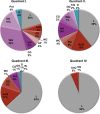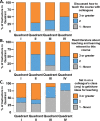A campus-wide study of STEM courses: new perspectives on teaching practices and perceptions
- PMID: 25452485
- PMCID: PMC4255349
- DOI: 10.1187/cbe.14-06-0108
A campus-wide study of STEM courses: new perspectives on teaching practices and perceptions
Abstract
At the University of Maine, middle and high school science, technology, engineering, and mathematics (STEM) teachers observed 51 STEM courses across 13 different departments and collected information on the active-engagement nature of instruction. The results of these observations show that faculty members teaching STEM courses cannot simply be classified into two groups, traditional lecturers or instructors who teach in a highly interactive manner, but instead exhibit a continuum of instructional behaviors between these two classifications. In addition, the observation data reveal that student behavior differs greatly in classes with varied levels of lecture. Although faculty members who teach large-enrollment courses are more likely to lecture, we also identified instructors of several large courses using interactive teaching methods. Observed faculty members were also asked to complete a survey about how often they use specific teaching practices, and we find that faculty members are generally self-aware of their own practices. Taken together, these findings provide comprehensive information about the range of STEM teaching practices at a campus-wide level and how such information can be used to design targeted professional development for faculty.
© 2014 M. K. Smith et al. CBE—Life Sciences Education © 2014 The American Society for Cell Biology. This article is distributed by The American Society for Cell Biology under license from the author(s). It is available to the public under an Attribution–Noncommercial–Share Alike 3.0 Unported Creative Commons License (http://creativecommons.org/licenses/by-nc-sa/3.0).
Figures








References
-
- American Association for the Advancement of Science. Vision and Change: A Call to Action. Washington, DC: 2010.
-
- Bell M. Supported reflective practice: a programme of peer observation and feedback for academic teaching development. Int J Acad Dev. 2001;6:29–39.
-
- Bonwell CC, Eison JA. Active Learning: Creating Excitement in the Classroom. Washington, DC: Association for the Study of Higher Education; 1991.
Publication types
MeSH terms
LinkOut - more resources
Full Text Sources
Other Literature Sources

